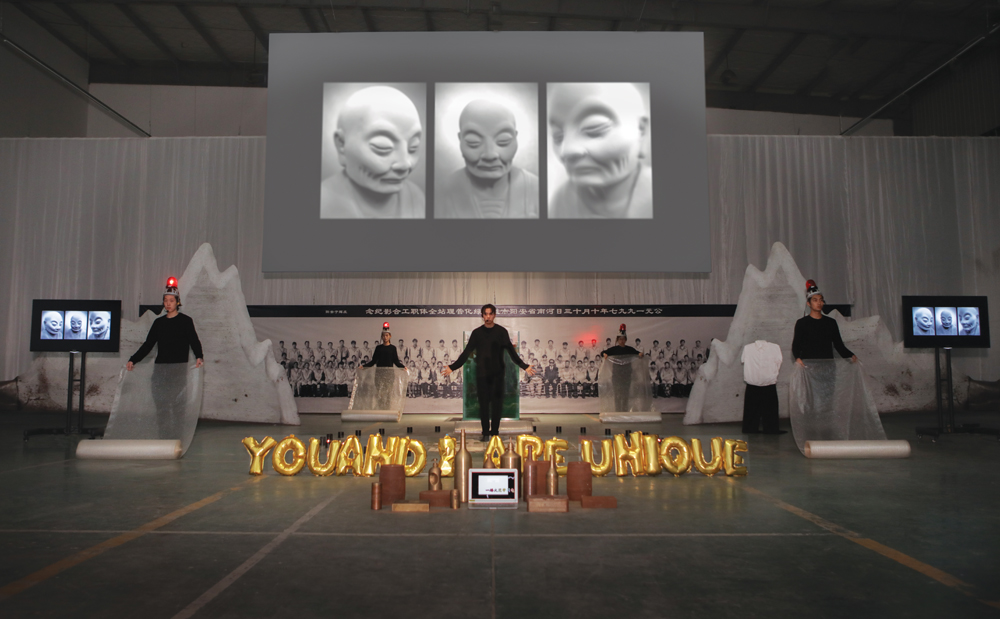Inventing Ritual
PIMO Contemporary Art Festival, Shanghai, China
PIMO Contemporary Art Festival, Shanghai, China

While the need for religion has been influx throughout history, the basic human requirement for ritual seems to have remained constant. How this phenomenon manifests itself in art was the subject of a performance-based exhibition organized by MadeIn Company (the alias of the artist Xu Zhen) together with artists Zhao Yao and Lu Pingyuan, which took place as part of the PIMO Contemporary Art Festival (named after a brand producing limited editions and other art products, foundedby Xu Zhen and collector David Chau).For the occasion, artists, curators and collectors were bussed in from Shanghaiand flown in from all over China to an artists’ studio complex in an industrial suburb of Shanghai where the festival took place. ‘Inventing Ritual’ took the form of a meticulously rehearsed, ritualistic, one-off performance lasting 45 minutes,with the work of dozens of Chinese artists each playing a role. This edition of the performance involved more artists than previous iterations (at Kunsthaus Graz and the Moscow Biennial in 2015). Here, the curators installed a physical structure in which static pieces became totems or ritual objects, while the ritual act itself was invoked through videos and performances. The result was an exhibition context where the situated artworks were used to reveal either an artistic compulsion to consciously explore ritual, or to suggest how ritual might be an unconscious part of an artist’s practice.
Major installations by Xu, He An, Zhang Hui and others, displayed symmetricallyon either side of a central space, formed a kind of stage on which the performance took place. A single projection screen hung from the ceiling at centre stage, flanked by two smaller monitors, with a circle of unlit candles placed on the ground. A cast of performers interpreted works individually or in groups, synchronized with video or photographic pieces shown on the three screens. Notablevideos included Concentration Training Camp (2007–08) by Zhou Xiaohu, in which actors, filmed upside-down, go through the cult-like training tactics for Amway sales representatives, and Yang Zhenzhong’s classic I Will Die (2000–05), which documents people saying ‘I will die’ to the camera in their own language. The latter was shown with Xu’s Physique of Consciousness (2011/2015), a tai-chi-like physical exercise consisting of religious gestures from all over the world. The large central screen was sometimes flanked by a different video work on the monitors, which, in turn, were joined by one or two thematically relevant performances. At the end of each section of the performance, an actor would use Wang Sishun’s Truth (2015) – a gaslight that Wang aims to keep alight for the rest of his life – to light one of the unlit candles.
The central idea of ‘Inventing Ritual’ was to take existing artists’ works and use them as layers or props in a choreographed performance. Normally, a process that involves turning artworks into props risks damaging or destroying their integrity but, strangely, this did not happen here. While the static installations functioned more like religious architecture than art, the more dynamic artworks took on new life and new meaning. This recontextualization of artworks felt like an original way to think about art and exhibition-making. At the same time, it did not really feel like a curated exhibition: the whole project bore the hallmark of Xu’s involvement beyond that of funder and co-curator. The way in which all the artworks were exhibited (or staged) seemed to be based on Xu’s retrospective at UCCA in 2014. In that show, the artist displayed his works in symmetrical formation on each side of UCCA’s cathedral-like space, riffing on the idea of museums functioning as churches in contemporary secular society, creatinga link between past religion and new art. In ‘Inventing Ritual’, Xu Zhen seems to have homed in on human ritual as an aspect of religious culture that has survived secularization. This can be also understood as part of Xu’s long-term project to explore human culture and ideology. The fact that he has created an artwork masquerading as an exhibition is yet another part of his life-work.
























